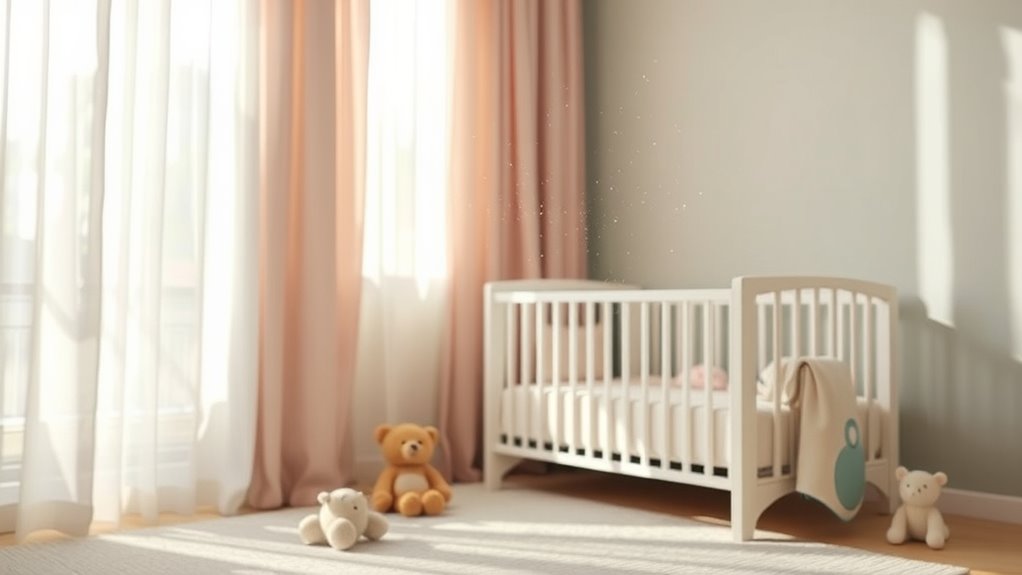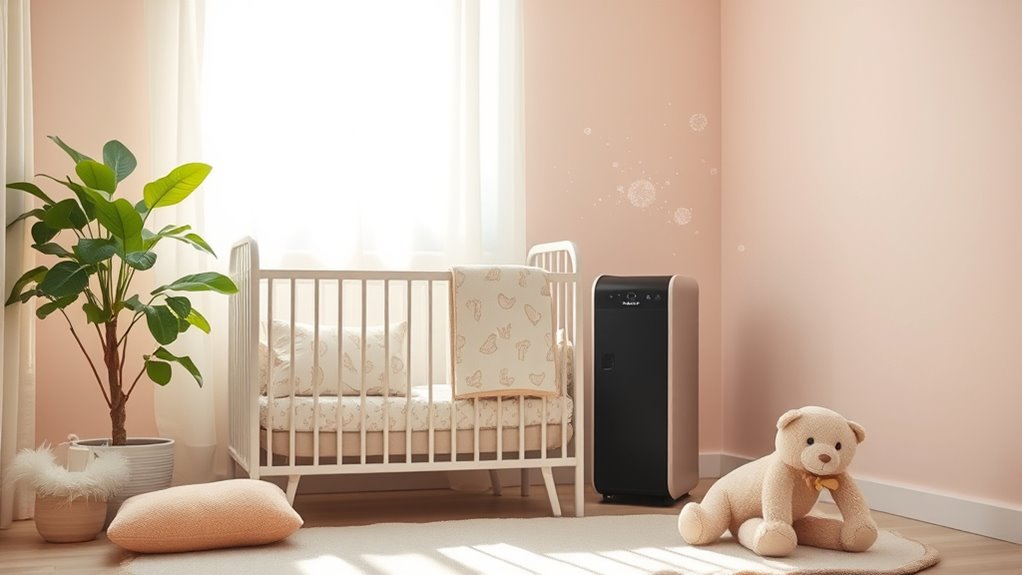If your nursery has poor indoor air quality, it could be making your baby sick by exposing them to allergens, airborne toxins, and mold spores that weaken their immune system. Factors like dust, pet dander, and humidity levels can worsen the situation. Using an air purifier with HEPA filters and maintaining good ventilation can help. Keep exploring ways to create a healthier environment, so you can guarantee your baby’s safety and well-being.
Key Takeaways
- Poor indoor air quality can cause allergies, respiratory issues, and infections in infants.
- Using air purifiers with HEPA filters reduces airborne allergens, bacteria, and viruses in the nursery.
- Maintaining humidity below 50% prevents mold growth that can harm your baby’s health.
- Proper ventilation and regular cleaning help eliminate dust, pet dander, and chemical pollutants.
- Monitoring air quality and investing in filtration creates a safer, healthier environment for your baby.

Have you ever wondered how the air inside your home affects your health? It’s easy to overlook, especially in a nursery where your focus is on your baby’s comfort and safety. But the quality of the air your little one breathes can have a crucial impact on their health and development. One effective way to improve indoor air quality is by using an air purifier. The benefits of air purifiers go beyond just freshening the air; they help reduce airborne particles that can trigger allergies, asthma, or other respiratory issues. Many models also feature filters designed to trap bacteria, viruses, and other pollutants, creating a cleaner environment for your baby to breathe.
Using an air purifier helps create a healthier, safer nursery environment for your baby’s development.
Another essential aspect of maintaining a healthy nursery is mold prevention. Mold spores thrive in humid environments, and if not controlled, they can lead to allergic reactions, respiratory problems, or even infections in your little one. An air purifier with a HEPA filter can be a game-changer here. These filters are capable of capturing mold spores, preventing them from circulating in the air. Regularly monitoring humidity levels in the nursery—keeping them below 50%—also helps inhibit mold growth, but an air purifier adds an extra layer of protection by continuously filtering the air.
Additionally, understanding the importance of indoor air quality can help you make informed decisions about your environment. By investing in an air purifier, you’re actively reducing the presence of airborne allergens and mold spores that could otherwise settle or grow in the nursery. This creates a safer, healthier space for your baby to rest, play, and grow. It’s especially beneficial if your home has pets, smokers, or if you live in an area prone to high humidity or pollution. The air purifier benefits extend beyond just removing visible dust or odors; they considerably cut down on microscopic irritants that can compromise your child’s immune system or worsen existing conditions.
Taking these steps shows you’re committed to providing a safe environment for your baby. Proper ventilation, combined with an effective air purifier, can make a noticeable difference in indoor air quality. Not only does this help prevent mold, but it also minimizes exposure to airborne toxins and allergens. As a parent, your goal is to create a space that supports your child’s health, and controlling indoor air quality is a crucial part of that. Investing in an air purifier and managing humidity levels are simple, proactive measures that can give you peace of mind, knowing you’re doing everything possible to keep your nursery a safe haven for your little one’s development.
Frequently Asked Questions
How Often Should I Replace Nursery Air Filters?
You should replace your nursery’s air filter regularly to maintain good air quality. Typically, filter maintenance involves changing filters every 1 to 3 months, depending on air filter types and usage. Check your filter’s manufacturer recommendations, as some filters, like HEPA, may last longer, while standard ones need more frequent replacement. Regularly inspecting and replacing your filters helps prevent dust and allergens from circulating, keeping your nursery healthier for your baby.
Can Houseplants Improve Nursery Air Quality?
While houseplants bring a touch of nature, they also offer plant benefits like improved air quality and pest control. You might think they only add beauty, but they actively filter toxins and reduce airborne pests, creating a healthier nursery environment. By choosing the right plants, you can enhance air freshness and curb pests naturally, making your nursery a safer space for your baby without relying solely on artificial air purifiers.
Are Air Purifiers Safe for Babies?
You might wonder if air purifier safety is a concern for your baby’s health implications. Generally, modern air purifiers are safe when used correctly, but it is crucial to choose models without ozone generators or harsh chemicals. Always read labels and follow manufacturer instructions. By doing so, you help protect your baby’s health, ensuring cleaner air in the nursery without risking any adverse effects from the purifier itself.
What Are Common Sources of Indoor Allergens in Nurseries?
Did you know that indoor allergens cause up to 50% of childhood asthma cases? Common sources in nurseries include dust mites and pet dander, which thrive on soft furnishings and carpets. Regular cleaning, using allergen-proof covers, and keeping pets out of the nursery can reduce exposure. You can also improve air quality with proper ventilation and air purifiers, helping keep your baby healthier and breathing easier.
How Does Humidity Affect Nursery Air Quality?
Humidity levels directly impact your nursery’s air quality. If the humidity is too high, it creates a perfect environment for mold growth, which can worsen allergies and respiratory issues for your baby. Conversely, low humidity can cause dry skin and irritation. Aim to keep humidity between 40-60% to minimize mold growth and maintain a healthier, more comfortable nursery environment for your little one.
Conclusion
Don’t delay in detecting dangers and dialing down dust, fumes, and fumes. By breathing in better air, you’re boosting your baby’s health and happiness. Keep your nursery fresh, filter out fumes, and foster a safe space for your little one to grow. Remember, vigilant vigilance and quick fixes can make a massive difference. Your baby’s bright, balanced, and beautiful future begins with your mindful management of home air quality today.










